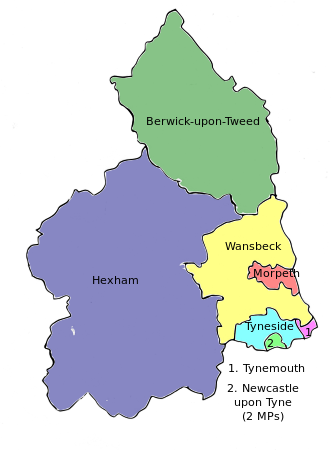|
History of parliamentary constituencies and boundaries in NorthumberlandThe county of Northumberland has returned four MPs to the UK Parliament since 1983. Under the 2023 review of Westminster constituencies, coming into effect for the 2024 general election, the boundary commission proposed that two of the four constituencies be shared with the county of Tyne and Wear. Under the Local Government Act 1972, which came into effect on 1 April 1974, the boundaries of the historic/administrative county were significantly altered with the south-east of the county, comprising more than half the electorate, being transferred to the new metropolitan county of Tyne and Wear. These changes were reflected in the following redistribution of parliamentary seats which did not come into effect until the 1983 general election, resulting in a reduction in the county's representation from 10 to 4 MPs. Number of seatsThe table below shows the number of MPs representing Northumberland at each major redistribution of seats affecting the county.
1Prior to 1950, seats were classified as County Divisions or Parliamentary Boroughs. Since 1950, they have been classified as County or Borough Constituencies. 2Approximate equivalent number of constituencies. Prior to the redistribution coming into effect for the 1983 general election, two constituencies were split between Northumberland and Tyne and Wear and two were wholly within the reconfigured county. 3Includes two cross-county border constituencies shared with Tyne and Wear. Constituencies timelineCounty seat Borough seat
Boundary reviewsPrior to 1832Since 1290, the Parliamentary County of Northumberland, along with all other English counties regardless of size or population, had elected two MPs (Knights of the Shire) to the House of Commons. The county also included three Parliamentary Boroughs, namely Berwick-upon-Tweed, Morpeth and Newcastle upon Tyne, all returning two MPs (burgesses) each. 1832The Great Reform Act of 1832 radically changed the representation of the House of Commons, with the County being divided into the Northern and Southern Divisions,[1] both returning two MPs.[2] The representation of Morpeth, which included the parish of Bedlington, was reduced to one MP.[3][4] Tynemouth was established as a single-member Borough[5] - named Tynemouth and North Shields under the Parliamentary Boundaries Act 1832.[6][7] 1868Under the Boundary Act 1868, the boundaries of Morpeth were further extended to include the townships of Cowpen and Newsham (which incorporprated the town of Blyth).[8][9] There were no other changes. 1885Under the Redistribution of Seats Act 1885, the two two-member county divisions were replaced by four single-member constituencies, namely Berwick-upon-Tweed, Wansbeck, Hexham and Tyneside.[10] The Parliamentary Borough of Berwick-upon-Tweed was abolished.[11] Tynemouth and North Shields became known as Tynemouth,[12] with no changes to its boundaries. 1918Under the Representation of the People Act 1918, the number of constituencies in Northumberland was increased back up to 10 as the two-member borough of Newcastle upon Tyne was replaced by four Divisions – Central, East, North and West.[13] The County Division of Tyneside was abolished and its contents distributed as follows:
Elsewhere, Berwick-upon-Tweed gained Amble from Wansbeck and Rothbury from Hexham, and Ashington was transferred from Wansbeck to Morpeth.[15] 1950As a result of the redistribution enacted by the Representation of the People Act 1948, Northumberland's representation remained at 10 MPs.[16] A new borough constituency named Blyth was established, which included the towns of Blyth and Bedlington, previously part of Morpeth. Wansbeck was abolished with its contents distributed as follows:
1955There was only one change resulting from the First Periodic Review of Westminster constituencies – the transfer of Benwell ward from Newcastle upon Tyne West to Newcastle upon Tyne Central.[17] 1974 (Feb)There were no changes resulting from the Second Periodic Review, which came into effect for the February 1974 election.[18] 1974 (Apr)Shortly after the Second Periodic Review came into effect, the county was subject to a major reconfiguration under the terms of the Local Government Act 1972. As a result, with effect from 1 April 1974, the four Newcastle upon Tyne constituencies and those of Wallsend and Tynemouth1, together with small areas of Hexham and Blyth, became part of the metropolitan county of Tyne and Wear. 1 Apart from the small community of Seaton Sluice. 1983The next change to parliamentary constituency boundaries, following the recommendations of the Third Periodic Review, reflected the change in county boundaries and reorganisation of local government authorities in 1974.[19] This review did not come into effect for a further nine years, at the 1983 general election, and resulted in the following changes:
1997There were no changes under the Fourth Review.[20] 2010At the Fifth Review there were only minor changes due to the revision of local authority ward boundaries.[21][22] 2024For the 2023 periodic review of Westminster constituencies, which redrew the constituency map ahead of the 2024 general election, the Boundary Commission for England opted to combine Northumberland with the Tyne and Wear boroughs of Newcastle upon Tyne and North Tyneside as a sub-region of the North East Region, with the creation of two cross-county boundary constituencies, resulting in the abolition of Berwick-upon-Tweed, Blyth Valley and Wansbeck.[23] [24] Detailed changes were as follows:
Maps
Communities timelineThe table below shows which constituencies represented major communities within the current county from 1885 onwards.
See also
References
|
|||||||||||||||||||||||||||||||||||||||||||||||||||||||||||||||||||||||||||||||||||||||||||||||||||||||||||||||||||||||||||||||||||||||||||||||||||||||||||||||||||||||||||||||||||||||||||||||||||||||||||||||||||||||||||||||||||||||||||||||||||||||||||||||||||||||||||||||||||||||||||||||||||||||||||





